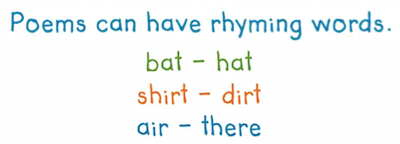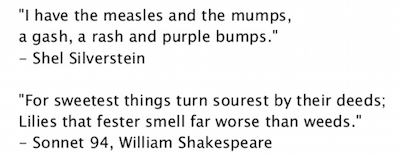4.2 How To Read A Poem With Rhythm By Identifying Rhyming Couplets
| Site: | Cowichan Valley School District - Moodle |
| Course: | ELA5, CSS, Sferrazza |
| Book: | 4.2 How To Read A Poem With Rhythm By Identifying Rhyming Couplets |
| Printed by: | Guest user |
| Date: | Friday, 26 December 2025, 7:58 AM |
Learning Targets
By the end of this lesson, you should be able to say YES to the following questions.
- Can you identify rhyming couplets and stanzas (features of written text) in poetry?
- Can you apply reading strategies to reading poetry with rhythm?

Reading Poetry Is A Skill
Reading poetry is a skill. Poems are often read more than one time.
- First reading:
- Try to get the "gist" of the poem - a sense of what the poem is about and a sense of how it may be read.
- Second reading:
- This is usually a slower read, where you try to understand the rhthym or rhyme (if any) and where you may underline, mark, or sticky note things you understand and things you do not yet understand. Then, you may look up words, talk about the poem to another person, or find another way to help you to understand words or lines that did not make sense at the beginning.
- Third + reading:
- This reading may be to answer specific questions about the setting, mood, characters, or meaning in the poem. It might be to read it with deeper understanding, to read it more fluently and expressively, or to answer specific questions about the poem. This is an important step in "Close Reading" of text.
This lesson will focus on the first and second reading of a poem. You will learn to identify stanzas, read and write rhyming couplets, and to read a poem with rhythm and rhyme.

Some Poems Have Stanzas
Poems can have stanzas. You may have heard them called verses.
Stanzas act like paragraphs:
- They break the poem into smaller chunks.
- They separate ideas.
- They have two or more lines that group according to length, beat, and often rhyming patterns.
Here is an example of the first two stanzas of a poem where each stanza has four lines:

Poems Can Have Rhyming Words and a Beat
Finding the rhyming words in a poem can help us to read it with rhythm. Many poems rhyme! If a poem has rhyming words, that can be a clue about how the poem should be read.

(adapted from learnzillion.com)
Video - How To Read a Poem With Rhythm By Identifying Rhyming Couplets
The following video features the poem, Casey at the Bat.
Casey at the Bat is a famous baseball poem written in 1888 by Ernest Thayer.
In the poem, a baseball team from the fictional town of Mudville is losing by two runs (points) with two outs (out of a possible three). They are in their last chance to score some runs, but they think they can win "if only" they can somehow get "mighty Casey" up to bat. Two weak hitters manage to get on base, and Casey comes to bat with a chance to tie the game.
Before watching the video below, find the poem, Casey at the Bat, in your Learning Guide and read through it once. Don't worry if you can't understand everything or if you can't read it perfectly. This is your "first read" in which you are trying to get the gist (the overall meaning/flow) of the poem.
After this video, you will be able to identify rhyming couplets.
Can You Identify Rhyming Couplets?
Do you see the word "couple" in couplet? A couple is two of something. Rhyming couplets are two poetry lines in a row that rhyme. They usually have the same rhythm.
Rhyming couplets are used in simple poems and in very complex poems (mumps and bumps). Even Dr. Seuss and Shakespeare used rhyming couplets.

Can You Read A Poem Well?
When you read poems, here are some skills to work on:
- Expression and volume - Can you adjust your volume and tone of voice to show emotion and/or mood?
- Clarity and Enunciation - Can you speak (articulate) clearly, with good pronunciation so each word can be understood?
- Pace and Fluency – Can you speak smoothly and fluently, with few hesitations?
Your Turn 1
In the video, rhyming couplets were marked in the first two stanzas of Casey at the Bat. This made it easier to read with a steady beat while stressing the rhyming words. In your Learning Guide, you will:
- Identify rhyming couplets in Casey at the Bat. You can mark them using lines like this:
![]()
- Practise reading Casey at the Bat aloud.
When you read Casey at the Bat aloud, try to practise reading it well. Work on:
-
-
-
-
-
- Expression and volume - Can you adjust your volume and tone of voice to show emotion and/or mood?
- Clarity and Enunciation - Can you speak (articulate) clearly, with good pronunciation so each word can be understood?
- Pace / Fluency – Can you speak smoothly and fluently, with few hesitations?
-
-
-
-
If you want to read along with a recording once or twice before trying on your own, there is a recording here: READ ALONG RECORDING
And here is a VERY expressive version of the poem:
Your Turn 2
- Read Casey at the Bat aloud to your home facilitator.
Talk about what you did well:
-
-
-
-
-
- Expression and volume - How well did you adjust your volume and tone of voice to show emotion and/or mood?
- Clarity and Enunciation - How well did you read (articulate) clearly, with good pronunciation so each word can be understood?
- Pace and Fluency – How well did you you read smoothly and fluently, with few hesitations?
-
-
-
-
- Make some rhyming couplets of your own in Make Your Own Couplets in your Learning Guide.

Note: There is an optional fun video on the next page you could look at after your Learning Guide work is completed. Also, today or tomorrow, you should add to your poetry reading journal to show your independent reading reflections.
Optional Fun
Enjoy watching Disney's 1946 version of Casey at the Bat.